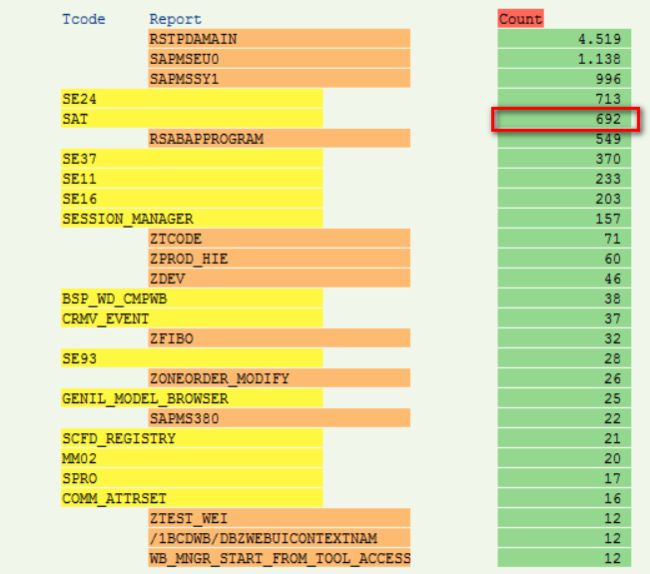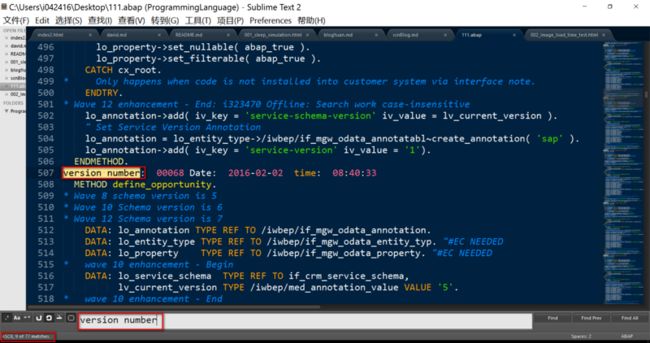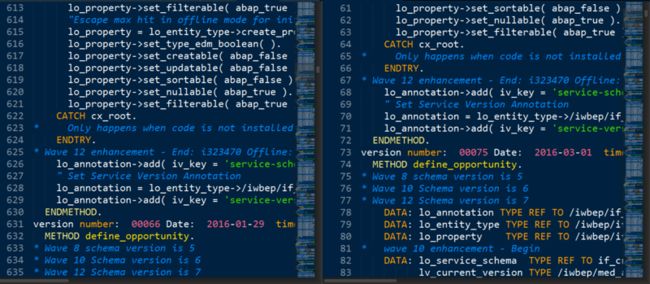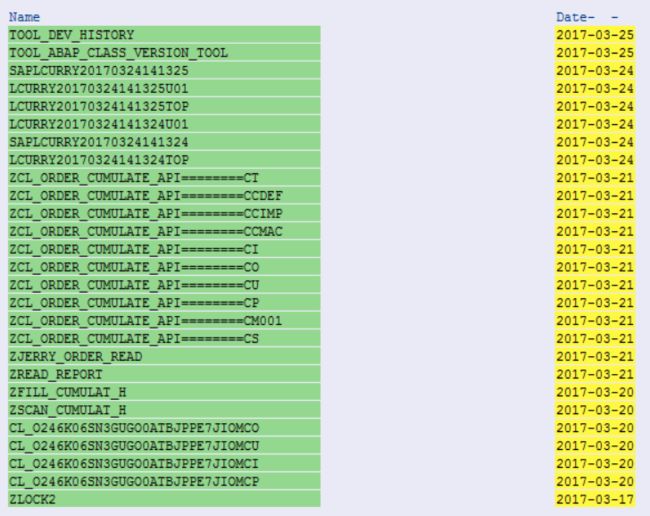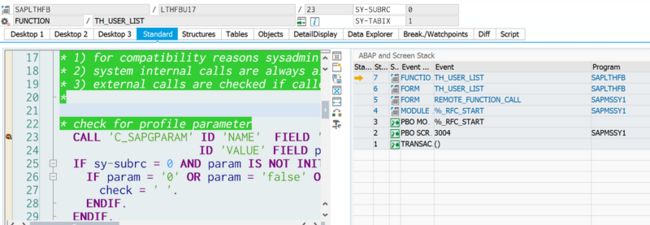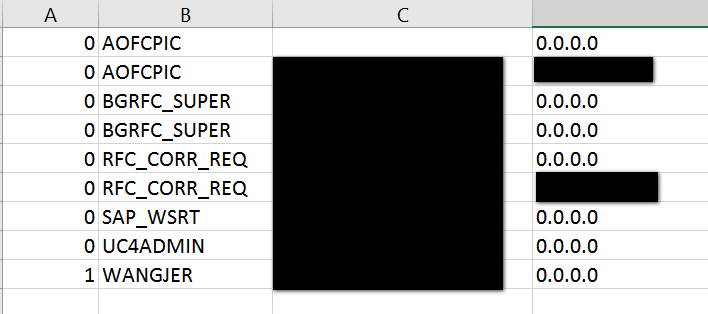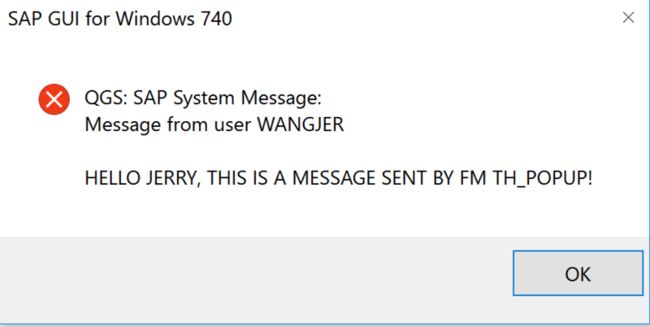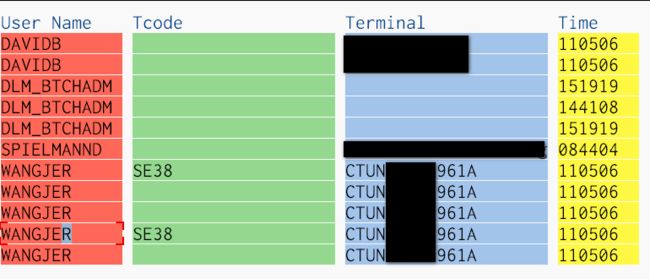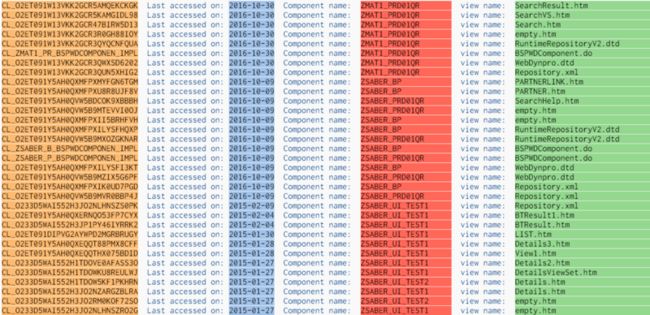I write some small ABAP tools for my daily work. Some of them might not be so useful at first glance – I just write them for fun. Some of them could be used to improve work efficiency, to just reduce several mouse clicks – I am too lazy
Tcode Usage Statistics Tool
This 56 lines of report can print the tcode usage for a given user per month.
REPORT ZTCODE.
PARAMETERS: month TYPE dats DEFAULT sy-datum OBLIGATORY,
user type usr02-bname OBLIGATORY DEFAULT sy-uname.
TYPES: BEGIN OF zusertcode,
operation type char30,
type type char10,
count TYPE swncshcnt,
END OF zusertcode.
TYPES: tt_zusertcode TYPE STANDARD TABLE OF zusertcode WITH KEY operation type.
DATA: lt_usertcode TYPE swnc_t_aggusertcode,
ls_result TYPE zusertcode,
lt_result TYPE tt_zusertcode.
CONSTANTS: cv_tcode TYPE char30 VALUE 'Tcode',
cv_report TYPE char30 VALUE 'Report',
cv_count TYPE char5 value 'Count'.
START-OF-SELECTION.
CALL FUNCTION 'SWNC_COLLECTOR_GET_AGGREGATES'
EXPORTING
component = 'TOTAL'
periodtype = 'M'
periodstrt = month
TABLES
usertcode = lt_usertcode
EXCEPTIONS
no_data_found = 1
OTHERS = 2.
DELETE lt_usertcode WHERE tasktype <> '01'.
LOOP AT lt_usertcode ASSIGNING FIELD-SYMBOL() WHERE account = user.
CLEAR: ls_result.
ls_result-operation = -entry_id.
ls_result-type = -entry_id+72.
ls_result-count = -count.
COLLECT ls_result INTO lt_result.
ENDLOOP.
SORT lt_result BY count DESCENDING.
WRITE: 10 cv_tcode, 20 cv_report, 60 cv_count COLOR COL_NEGATIVE.
LOOP AT lt_result ASSIGNING FIELD-SYMBOL().
IF -type = 'T'.
WRITE: / -operation COLOR COL_TOTAL UNDER cv_tcode,
-count COLOR COL_POSITIVE UNDER cv_count.
ELSE.
WRITE: / -operation COLOR COL_GROUP UNDER cv_report,
-count COLOR COL_POSITIVE UNDER cv_count.
ENDIF.
ENDLOOP. For example if you would like to check the tcode usage for user WANGJER during March 2017, you have to just choose any date in March and execute:
It shows I have used SAT for 692 times. Looks like I have some performance trouble on March?
The similar function could be found in tcode ST03N.
ABAP Class Version Browse Tool
ABAP workbench has built-in version management tool.
The version comparison could only be performed against two version at a time.
Sometimes I have the requirement to do some pure text analysis on the source code version, for example I need to figure out on which version a variable is introduced. So I write this small tool, which can downloads all the versions of source code into a text file, then I can simply use text analysis tool to fulfill my query.
Execute this 38 lines of tool and it will print out the source code of all versions of specified method.
REPORT tool_abap_class_version_tool.
PARAMETERS: cname TYPE seocompo-clsname OBLIGATORY DEFAULT 'CL_CRM_OPPORTUNITY_MPC_EXT',
mname TYPE seocompo-cmpname OBLIGATORY DEFAULT 'DEFINE_OPPORTUNITY'.
DATA: lv_name TYPE vrsd-objname,
lt_version TYPE STANDARD TABLE OF vrsd,
lt_table TYPE STANDARD TABLE OF abaptxt255,
lt_trdir TYPE STANDARD TABLE OF trdir,
lt_vsmodisrc TYPE STANDARD TABLE OF smodisrc,
lt_vsmodilog TYPE STANDARD TABLE OF smodilog.
lv_name = cname && '%' && mname.
SELECT objname versno datum zeit FROM vrsd INTO CORRESPONDING FIELDS OF TABLE lt_version
WHERE objname LIKE lv_name ORDER BY versno DESCENDING. "#EC CI_NOFIRST
LOOP AT lt_version ASSIGNING FIELD-SYMBOL().
CALL FUNCTION 'SVRS_GET_REPS_FROM_OBJECT'
EXPORTING
object_name = -objname
object_type = 'METH'
versno = -versno
TABLES
repos_tab = lt_table
trdir_tab = lt_trdir
vsmodisrc = lt_vsmodisrc
vsmodilog = lt_vsmodilog.
ASSERT sy-subrc = 0.
WRITE: / 'version number: ' COLOR COL_GROUP, -versno COLOR COL_NEGATIVE,
'Date: ' COLOR COL_KEY, -datum COLOR COL_HEADING, ' time: ' COLOR COL_POSITIVE, -zeit COLOR COL_NORMAL.
LOOP AT lt_table ASSIGNING FIELD-SYMBOL().
WRITE: / -line.
ENDLOOP.
ENDLOOP. The left task is to download it locally via Workbench:
Now I can review all the 77 versions of this method in a single text file.
Sublime Text is my favorite local text editor, as you can see from above screenshot there is also ABAP plugin for it to display ABAP source code with correct syntax highlight.
In Sublime Text it is possible to open the same file in separate two views so it is very convenience for me now to compare any two versions within the same editor window.
Development History Trace Tool
For example if I would like to recall what I have changed between 2017-03-01 and 2017-03-25, I can simply execute this 67 lines of reports:
PARAMETERS: name TYPE usr02-bname OBLIGATORY,
fro TYPE sy-datum OBLIGATORY DEFAULT sy-datum,
to_ TYPE sy-datum OBLIGATORY DEFAULT sy-datum.
CONSTANTS: c_name TYPE trdir-name VALUE 'Name',
c_date TYPE trdir-udat VALUE 'Date'.
AT SELECTION-SCREEN.
IF fro > to_.
WRITE: / 'Invalid date period.' COLOR COL_NEGATIVE.
RETURN.
ENDIF.
START-OF-SELECTION.
DATA: lt_record TYPE STANDARD TABLE OF trdir.
SELECT name udat INTO CORRESPONDING FIELDS OF TABLE lt_record FROM trdir
WHERE unam = name AND udat BETWEEN fro AND to_.
IF sy-subrc <> 0.
WRITE: / 'No record found at given date period.' COLOR COL_NEGATIVE.
RETURN.
ENDIF.
SORT lt_record BY udat DESCENDING.
WRITE: 10 c_name, 80 c_date.
LOOP AT lt_record INTO DATA(ls_data).
WRITE: / ls_data-name UNDER c_name COLOR COL_POSITIVE, ls_data-udat UNDER c_date COLOR COL_TOTAL.
HIDE ls_data-name.
ENDLOOP.
AT LINE-SELECTION.
DATA: bdcdata_tab TYPE TABLE OF bdcdata,
opt TYPE ctu_params,
bdcdata_line TYPE bdcdata.
bdcdata_line-program = 'SAPLWBABAP'.
bdcdata_line-dynpro = '0100'.
bdcdata_line-dynbegin = 'X'.
APPEND bdcdata_line TO bdcdata_tab.
CLEAR: bdcdata_line.
bdcdata_line-fnam = 'BDC_CURSOR'.
bdcdata_line-fval = 'RS38M-PROGRAMM'.
APPEND bdcdata_line TO bdcdata_tab.
CLEAR: bdcdata_line.
bdcdata_line-fnam = 'BDC_OKCODE'.
bdcdata_line-fval = '=SHOP'.
APPEND bdcdata_line TO bdcdata_tab.
CLEAR: bdcdata_line.
bdcdata_line-fnam = 'RS38M-PROGRAMM'.
bdcdata_line-fval = ls_data-name.
APPEND bdcdata_line TO bdcdata_tab.
opt-dismode = 'E'.
opt-defsize = 'X'.
CALL TRANSACTION 'SE38' USING bdcdata_tab OPTIONS FROM opt.
CLEAR: bdcdata_tab.Double click on each entry, and ABAP editor will be opened to allow me to review the source code of chosen entry.
This tool is especially useful for me as when I grow old, sometimes I didn’t remember what I have changed several days ago, and if I only make changes on Z objects then there will be no log in transport requests. Use this tool and I can immediately realize what I have changed for a given time interval.
Execute some transaction code without logging on to backend system
Suppose I am too lazy to log on a backend system to execute transaction code SM04. Then I can trigger it in excel and review result there as well.
Then I just create an excel with Macro enabled ( .xlsm ), put a button and assign the following VB code to it:
Sub CommandButton1_Click()
Set R3 = CreateObject("SAP.Functions")
Set myConnction = R3.Connection
myConnction.ApplicationServer = "replace with your own host name here!!!"
myConnction.SystemNumber = 54
myConnction.Client = "001"
myConnction.user = "replace with your own user here!!!"
myConnction.Password = "replace with your own password here!!!"
If myConnction.Logon(0, True) <> True Then
MsgBox "Logon failed"
Exit Sub
End If
Dim callFunctionModule As Object
Set callFunctionModule = R3.Add("TH_USER_LIST")
callFunctionModule.Call
If callFunctionModule.Exception <> "" Then
MsgBox callFunctionModule.Exception
End If
If callFunctionModule.Call = True Then
Dim result As Object
Set result = callFunctionModule.tables("USRLIST")
Dim aSheet As Worksheet
Dim sheetCol As New Collection
sheetCol.Add ActiveWorkbook.Sheets(1)
For Each aSheet In sheetCol
Dim i As Integer
i = 1
For Each user In result.Rows
Client = user(2)
UserName = user(3)
Terminal = user(5)
IP = user(16)
aSheet.Cells(i, 1) = Client
aSheet.Cells(i, 2) = UserName
aSheet.Cells(i, 3) = Terminal
aSheet.Cells(i, 4) = IP
i = i + 1
Next
Next
Else
MsgBox " Call Failed! error: "
End If
'log off
myConnction.logoff
End SubWith this script I am calling function module TH_USER_LIST from excel, parse the result and display them in excel.
Now I click the button, I can observe in ABAP system that the function module TH_USER_LIST is called:
And result is displayed in excel:
XML difference compare tool
No need to download additional software to compare the different XML, as there is a standard class cl_proxy_ui_utils which can do this task for you.
See the following sample code:
DATA: lv_original TYPE xstring,
lv_changed TYPE xstring.
lv_original = zcl_jerry_tool=>get_file_binary_by_path( 'C:\temp\1.xml' ).
lv_changed = zcl_jerry_tool=>get_file_binary_by_path( 'C:\temp\2.xml' ).
CALL METHOD cl_proxy_ui_utils=>show_xml_diff
EXPORTING
doc1 = lv_original
doc2 = lv_changed.Execute the report and there will be a popup where the difference is displayed. The implementation of
Mischief: send a message to another online user
The function module TH_POPUP can generate a popup window for a given online dialog user.
See example below:
Once executed, I will see a popup in my SAPGUI:
I have then written a report using this FM.
Once this report is executed, you can see a list of online users in current application server, which has the same content as in tcode SM04.
Double click on a given user, and he / she will see a popup dialog in his SAPGUI. You can use this mischief report to greet your colleague, for example send a message like “hey guys, you’d better stand up and have a cup of coffee” after you see he / she has already debugged one issue for half an hour?
BSP page browse history tool
The title might be a little bit misleading. To be more exact, this tool lists all automatically generated ABAP classes for BSP pages accessed by a given user.
Simply execute the report with a user name:
And detail browser list is displayed:
You can find more background information regarding BSP and JSP, and also the source code of this tool from my blog JSP attribute tag used in Hybris UI implementation and counterpart in ABAP BSP.
要获取更多Jerry的原创文章,请关注公众号"汪子熙":![]()
I write some small ABAP tools for my daily work. Some of them might not be so useful at first glance – I just write them for fun. Some of them could be used to improve work efficiency, to just reduce several mouse clicks – I am too lazy
Tcode Usage Statistics Tool
This 56 lines of report can print the tcode usage for a given user per month.
REPORT ZTCODE.
PARAMETERS: month TYPE dats DEFAULT sy-datum OBLIGATORY,
user type usr02-bname OBLIGATORY DEFAULT sy-uname.
TYPES: BEGIN OF zusertcode,
operation type char30,
type type char10,
count TYPE swncshcnt,
END OF zusertcode.
TYPES: tt_zusertcode TYPE STANDARD TABLE OF zusertcode WITH KEY operation type.
DATA: lt_usertcode TYPE swnc_t_aggusertcode,
ls_result TYPE zusertcode,
lt_result TYPE tt_zusertcode.
CONSTANTS: cv_tcode TYPE char30 VALUE 'Tcode',
cv_report TYPE char30 VALUE 'Report',
cv_count TYPE char5 value 'Count'.
START-OF-SELECTION.
CALL FUNCTION 'SWNC_COLLECTOR_GET_AGGREGATES'
EXPORTING
component = 'TOTAL'
periodtype = 'M'
periodstrt = month
TABLES
usertcode = lt_usertcode
EXCEPTIONS
no_data_found = 1
OTHERS = 2.
DELETE lt_usertcode WHERE tasktype <> '01'.
LOOP AT lt_usertcode ASSIGNING FIELD-SYMBOL() WHERE account = user.
CLEAR: ls_result.
ls_result-operation = -entry_id.
ls_result-type = -entry_id+72.
ls_result-count = -count.
COLLECT ls_result INTO lt_result.
ENDLOOP.
SORT lt_result BY count DESCENDING.
WRITE: 10 cv_tcode, 20 cv_report, 60 cv_count COLOR COL_NEGATIVE.
LOOP AT lt_result ASSIGNING FIELD-SYMBOL().
IF -type = 'T'.
WRITE: / -operation COLOR COL_TOTAL UNDER cv_tcode,
-count COLOR COL_POSITIVE UNDER cv_count.
ELSE.
WRITE: / -operation COLOR COL_GROUP UNDER cv_report,
-count COLOR COL_POSITIVE UNDER cv_count.
ENDIF.
ENDLOOP. For example if you would like to check the tcode usage for user WANGJER during March 2017, you have to just choose any date in March and execute:
It shows I have used SAT for 692 times. Looks like I have some performance trouble on March?
The similar function could be found in tcode ST03N.
ABAP Class Version Browse Tool
ABAP workbench has built-in version management tool.
The version comparison could only be performed against two version at a time.
Sometimes I have the requirement to do some pure text analysis on the source code version, for example I need to figure out on which version a variable is introduced. So I write this small tool, which can downloads all the versions of source code into a text file, then I can simply use text analysis tool to fulfill my query.
Execute this 38 lines of tool and it will print out the source code of all versions of specified method.
REPORT tool_abap_class_version_tool.
PARAMETERS: cname TYPE seocompo-clsname OBLIGATORY DEFAULT 'CL_CRM_OPPORTUNITY_MPC_EXT',
mname TYPE seocompo-cmpname OBLIGATORY DEFAULT 'DEFINE_OPPORTUNITY'.
DATA: lv_name TYPE vrsd-objname,
lt_version TYPE STANDARD TABLE OF vrsd,
lt_table TYPE STANDARD TABLE OF abaptxt255,
lt_trdir TYPE STANDARD TABLE OF trdir,
lt_vsmodisrc TYPE STANDARD TABLE OF smodisrc,
lt_vsmodilog TYPE STANDARD TABLE OF smodilog.
lv_name = cname && '%' && mname.
SELECT objname versno datum zeit FROM vrsd INTO CORRESPONDING FIELDS OF TABLE lt_version
WHERE objname LIKE lv_name ORDER BY versno DESCENDING. "#EC CI_NOFIRST
LOOP AT lt_version ASSIGNING FIELD-SYMBOL().
CALL FUNCTION 'SVRS_GET_REPS_FROM_OBJECT'
EXPORTING
object_name = -objname
object_type = 'METH'
versno = -versno
TABLES
repos_tab = lt_table
trdir_tab = lt_trdir
vsmodisrc = lt_vsmodisrc
vsmodilog = lt_vsmodilog.
ASSERT sy-subrc = 0.
WRITE: / 'version number: ' COLOR COL_GROUP, -versno COLOR COL_NEGATIVE,
'Date: ' COLOR COL_KEY, -datum COLOR COL_HEADING, ' time: ' COLOR COL_POSITIVE, -zeit COLOR COL_NORMAL.
LOOP AT lt_table ASSIGNING FIELD-SYMBOL().
WRITE: / -line.
ENDLOOP.
ENDLOOP. The left task is to download it locally via Workbench:
Now I can review all the 77 versions of this method in a single text file.
Sublime Text is my favorite local text editor, as you can see from above screenshot there is also ABAP plugin for it to display ABAP source code with correct syntax highlight.
In Sublime Text it is possible to open the same file in separate two views so it is very convenience for me now to compare any two versions within the same editor window.
Development History Trace Tool
For example if I would like to recall what I have changed between 2017-03-01 and 2017-03-25, I can simply execute this 67 lines of reports:
PARAMETERS: name TYPE usr02-bname OBLIGATORY,
fro TYPE sy-datum OBLIGATORY DEFAULT sy-datum,
to_ TYPE sy-datum OBLIGATORY DEFAULT sy-datum.
CONSTANTS: c_name TYPE trdir-name VALUE 'Name',
c_date TYPE trdir-udat VALUE 'Date'.
AT SELECTION-SCREEN.
IF fro > to_.
WRITE: / 'Invalid date period.' COLOR COL_NEGATIVE.
RETURN.
ENDIF.
START-OF-SELECTION.
DATA: lt_record TYPE STANDARD TABLE OF trdir.
SELECT name udat INTO CORRESPONDING FIELDS OF TABLE lt_record FROM trdir
WHERE unam = name AND udat BETWEEN fro AND to_.
IF sy-subrc <> 0.
WRITE: / 'No record found at given date period.' COLOR COL_NEGATIVE.
RETURN.
ENDIF.
SORT lt_record BY udat DESCENDING.
WRITE: 10 c_name, 80 c_date.
LOOP AT lt_record INTO DATA(ls_data).
WRITE: / ls_data-name UNDER c_name COLOR COL_POSITIVE, ls_data-udat UNDER c_date COLOR COL_TOTAL.
HIDE ls_data-name.
ENDLOOP.
AT LINE-SELECTION.
DATA: bdcdata_tab TYPE TABLE OF bdcdata,
opt TYPE ctu_params,
bdcdata_line TYPE bdcdata.
bdcdata_line-program = 'SAPLWBABAP'.
bdcdata_line-dynpro = '0100'.
bdcdata_line-dynbegin = 'X'.
APPEND bdcdata_line TO bdcdata_tab.
CLEAR: bdcdata_line.
bdcdata_line-fnam = 'BDC_CURSOR'.
bdcdata_line-fval = 'RS38M-PROGRAMM'.
APPEND bdcdata_line TO bdcdata_tab.
CLEAR: bdcdata_line.
bdcdata_line-fnam = 'BDC_OKCODE'.
bdcdata_line-fval = '=SHOP'.
APPEND bdcdata_line TO bdcdata_tab.
CLEAR: bdcdata_line.
bdcdata_line-fnam = 'RS38M-PROGRAMM'.
bdcdata_line-fval = ls_data-name.
APPEND bdcdata_line TO bdcdata_tab.
opt-dismode = 'E'.
opt-defsize = 'X'.
CALL TRANSACTION 'SE38' USING bdcdata_tab OPTIONS FROM opt.
CLEAR: bdcdata_tab.Double click on each entry, and ABAP editor will be opened to allow me to review the source code of chosen entry.
This tool is especially useful for me as when I grow old, sometimes I didn’t remember what I have changed several days ago, and if I only make changes on Z objects then there will be no log in transport requests. Use this tool and I can immediately realize what I have changed for a given time interval.
Execute some transaction code without logging on to backend system
Suppose I am too lazy to log on a backend system to execute transaction code SM04. Then I can trigger it in excel and review result there as well.
Then I just create an excel with Macro enabled ( .xlsm ), put a button and assign the following VB code to it:
Sub CommandButton1_Click()
Set R3 = CreateObject("SAP.Functions")
Set myConnction = R3.Connection
myConnction.ApplicationServer = "replace with your own host name here!!!"
myConnction.SystemNumber = 54
myConnction.Client = "001"
myConnction.user = "replace with your own user here!!!"
myConnction.Password = "replace with your own password here!!!"
If myConnction.Logon(0, True) <> True Then
MsgBox "Logon failed"
Exit Sub
End If
Dim callFunctionModule As Object
Set callFunctionModule = R3.Add("TH_USER_LIST")
callFunctionModule.Call
If callFunctionModule.Exception <> "" Then
MsgBox callFunctionModule.Exception
End If
If callFunctionModule.Call = True Then
Dim result As Object
Set result = callFunctionModule.tables("USRLIST")
Dim aSheet As Worksheet
Dim sheetCol As New Collection
sheetCol.Add ActiveWorkbook.Sheets(1)
For Each aSheet In sheetCol
Dim i As Integer
i = 1
For Each user In result.Rows
Client = user(2)
UserName = user(3)
Terminal = user(5)
IP = user(16)
aSheet.Cells(i, 1) = Client
aSheet.Cells(i, 2) = UserName
aSheet.Cells(i, 3) = Terminal
aSheet.Cells(i, 4) = IP
i = i + 1
Next
Next
Else
MsgBox " Call Failed! error: "
End If
'log off
myConnction.logoff
End SubWith this script I am calling function module TH_USER_LIST from excel, parse the result and display them in excel.
Now I click the button, I can observe in ABAP system that the function module TH_USER_LIST is called:
And result is displayed in excel:
XML difference compare tool
No need to download additional software to compare the different XML, as there is a standard class cl_proxy_ui_utils which can do this task for you.
See the following sample code:
DATA: lv_original TYPE xstring,
lv_changed TYPE xstring.
lv_original = zcl_jerry_tool=>get_file_binary_by_path( 'C:\temp\1.xml' ).
lv_changed = zcl_jerry_tool=>get_file_binary_by_path( 'C:\temp\2.xml' ).
CALL METHOD cl_proxy_ui_utils=>show_xml_diff
EXPORTING
doc1 = lv_original
doc2 = lv_changed.Execute the report and there will be a popup where the difference is displayed. The implementation of
Mischief: send a message to another online user
The function module TH_POPUP can generate a popup window for a given online dialog user.
See example below:
Once executed, I will see a popup in my SAPGUI:
I have then written a report using this FM.
Once this report is executed, you can see a list of online users in current application server, which has the same content as in tcode SM04.
Double click on a given user, and he / she will see a popup dialog in his SAPGUI. You can use this mischief report to greet your colleague, for example send a message like “hey guys, you’d better stand up and have a cup of coffee” after you see he / she has already debugged one issue for half an hour?
BSP page browse history tool
The title might be a little bit misleading. To be more exact, this tool lists all automatically generated ABAP classes for BSP pages accessed by a given user.
Simply execute the report with a user name:
And detail browser list is displayed:
You can find more background information regarding BSP and JSP, and also the source code of this tool from my blog JSP attribute tag used in Hybris UI implementation and counterpart in ABAP BSP.
要获取更多Jerry的原创文章,请关注公众号"汪子熙":![]()

